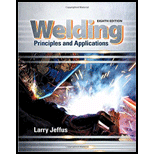
Bundle: Welding: Principles and Applications, 8th + MindTap Welding, 4 terms (24 months) Printed Access Card
8th Edition
ISBN: 9781337219426
Author: Larry Jeffus
Publisher: Cengage Learning
expand_more
expand_more
format_list_bulleted
Concept explainers
Textbook Question
Chapter 12, Problem 17R
What benefit does adding an externally supplied shielding gas have on some rutile-based electrodes?
Expert Solution & Answer
Trending nowThis is a popular solution!

Students have asked these similar questions
Practice
L[sin at]
Find the Hertzian stresses and the maximum shear stress for the wheel.
Can I get help on this question?
Chapter 12 Solutions
Bundle: Welding: Principles and Applications, 8th + MindTap Welding, 4 terms (24 months) Printed Access Card
Ch. 12 - List some factors that have led to the increased...Ch. 12 - How is FCAW similar to GMAW?Ch. 12 - What does the FCA flux provide to the weld?Ch. 12 - What are the major atmospheric contaminations of...Ch. 12 - How does slag help an FCA weld?Ch. 12 - How can FCA welding guns be cooled?Ch. 12 - Excessive drive roller pressure causes what...Ch. 12 - List the advantages that FCA welding offers the...Ch. 12 - Describe the two methods of manufacturing FCA...Ch. 12 - Why are the large diameter electrodes not used for...
Ch. 12 - How do deoxidizers remove oxygen from the weld...Ch. 12 - What do fluxing agents do for a weld?Ch. 12 - Why are alloying elements added to the flux?Ch. 12 - How does the flux form a shielding gas to protect...Ch. 12 - What are the main limitations of the rutile...Ch. 12 - Why is it more difficult to use lime-based fluxed...Ch. 12 - What benefit does adding an externally supplied...Ch. 12 - How do excessive amounts of manganese affect a...Ch. 12 - Why are elements added that cause ferrite to form...Ch. 12 - Why must a flux form a less dense slag?Ch. 12 - Referring to Table 12-5, what is the AWS...Ch. 12 - Describe the meaning of each part of the following...Ch. 12 - What does the number 316 in E316T-1 mean?Ch. 12 - What is the advantage of using an argon- CO2 mixed...Ch. 12 - Why are some slags called refractory?Ch. 12 - What can happen to slag that solidifies on the...Ch. 12 - How is the electrode extension measured?Ch. 12 - What can cause porosity in an FCA weld?Ch. 12 - What happens to water in the welding arc?Ch. 12 - What is the thin dark gray or black layer on new...Ch. 12 - Why is uniformly scattered porosity hard to detect...Ch. 12 - What cautions must be taken when chemically...
Knowledge Booster
Learn more about
Need a deep-dive on the concept behind this application? Look no further. Learn more about this topic, mechanical-engineering and related others by exploring similar questions and additional content below.Similar questions
- During some actual expansion and compression processes in piston–cylinder devices, the gases have been observed to satisfy the relationship PVn = C, where n and C are constants. Calculate the work done when a gas expands from 350 kPa and 0.03 m3 to a final volume of 0.2 m3 for the case of n = 1.5. The work done in this case is kJ.arrow_forwardCarbon dioxide contained in a piston–cylinder device is compressed from 0.3 to 0.1 m3. During the process, the pressure and volume are related by P = aV–2, where a = 6 kPa·m6. Calculate the work done on carbon dioxide during this process. The work done on carbon dioxide during this process is kJ.arrow_forwardThe volume of 1 kg of helium in a piston–cylinder device is initially 5 m3. Now helium is compressed to 3 m3 while its pressure is maintained constant at 130 kPa. Determine the initial and final temperatures of helium as well as the work required to compress it, in kJ. The gas constant of helium is R = 2.0769 kJ/kg·K. The initial temperature of helium is K. The final temperature of helium is K. The work required to compress helium is kJ.arrow_forward
- A piston-cylinder device initially contains 0.4 kg of nitrogen gas at 160 kPa and 140°C. Nitrogen is now expanded isothermally to a pressure of 80 kPa. Determine the boundary work done during this process. The properties of nitrogen are R= 0.2968 kJ/kg-K and k= 1.4. N₂ 160 kPa 140°C The boundary work done during this process is KJ.arrow_forward! Required information An abrasive cutoff wheel has a diameter of 5 in, is 1/16 in thick, and has a 3/4-in bore. The wheel weighs 4.80 oz and runs at 11,700 rev/min. The wheel material is isotropic, with a Poisson's ratio of 0.20, and has an ultimate strength of 12 kpsi. Choose the correct equation from the following options: Multiple Choice о σmax= (314) (4r2 — r²) - о σmax = p² (3+) (4r² + r²) 16 σmax = (314) (4r² + r²) σmax = (314) (4² - r²)arrow_forwardI don't know how to solve thisarrow_forward
- I am not able to solve this question. Each part doesn't make sense to me.arrow_forwardExercises Find the solution of the following Differential Equations 1) y" + y = 3x² 3) "+2y+3y=27x 5) y"+y=6sin(x) 7) y"+4y+4y = 18 cosh(x) 9) (4)-5y"+4y = 10 cos(x) 11) y"+y=x²+x 13) y"-2y+y=e* 15) y+2y"-y'-2y=1-4x³ 2) y"+2y' + y = x² 4) "+y=-30 sin(4x) 6) y"+4y+3y=sin(x)+2 cos(x) 8) y"-2y+2y= 2e* cos(x) 10) y+y-2y=3e* 12) y"-y=e* 14) y"+y+y=x+4x³ +12x² 16) y"-2y+2y=2e* cos(x)arrow_forwardQu. 15 What are the indices for the Plane 1 drawn in the following sketch? Qu. 16 What are the Miller indices for the Plane shown in the following cubic unit cell? this is material engineering please show all workarrow_forward
arrow_back_ios
SEE MORE QUESTIONS
arrow_forward_ios
Recommended textbooks for you
 Welding: Principles and Applications (MindTap Cou...Mechanical EngineeringISBN:9781305494695Author:Larry JeffusPublisher:Cengage Learning
Welding: Principles and Applications (MindTap Cou...Mechanical EngineeringISBN:9781305494695Author:Larry JeffusPublisher:Cengage Learning

Welding: Principles and Applications (MindTap Cou...
Mechanical Engineering
ISBN:9781305494695
Author:Larry Jeffus
Publisher:Cengage Learning
Metal Joining Process-Welding, Brazing and Soldering; Author: Toc H Kochi;https://www.youtube.com/watch?v=PPT5_fDSzGY;License: Standard YouTube License, CC-BY